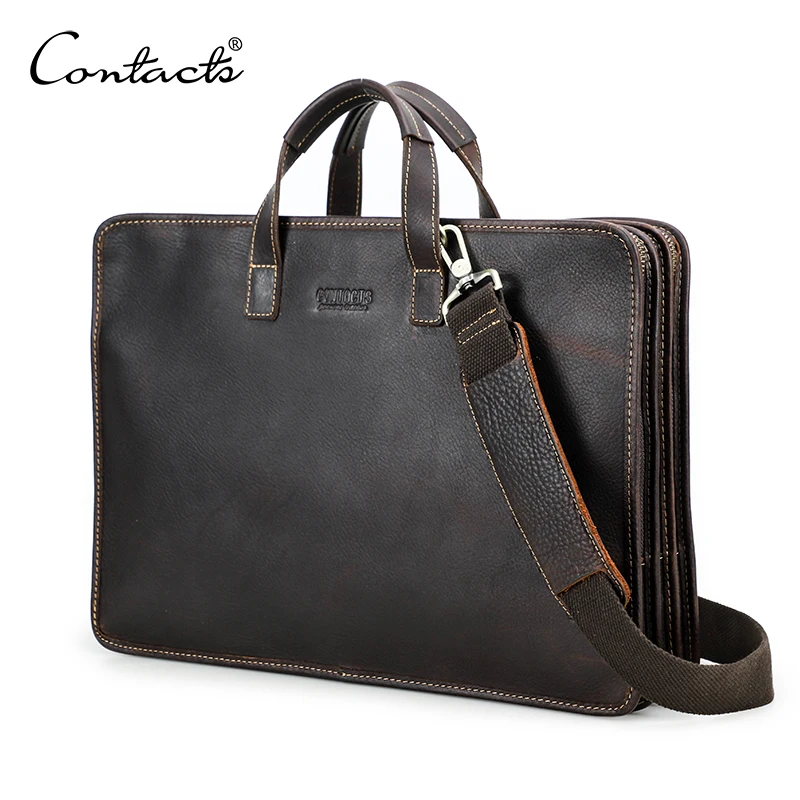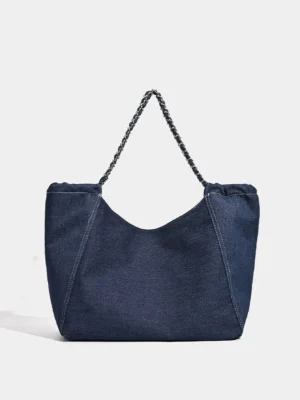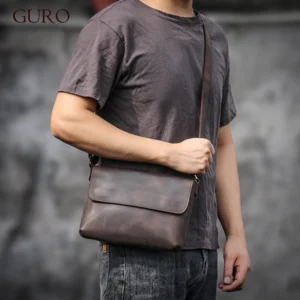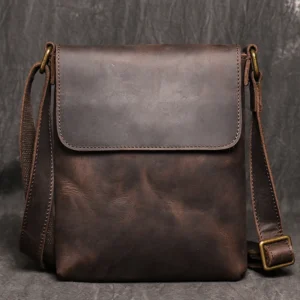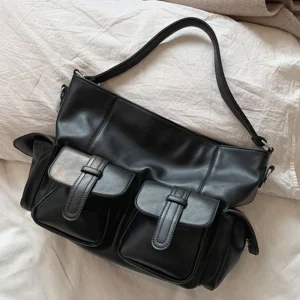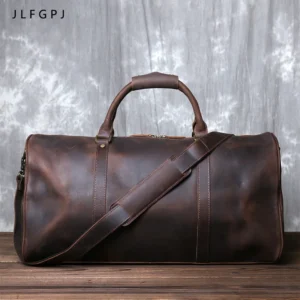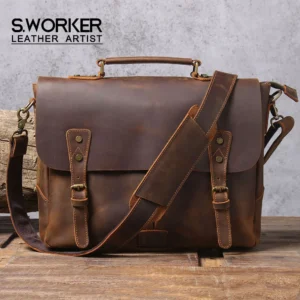Why Messenger Bag Material Matters for Long-Term Satisfaction
When selecting a messenger bag, the material isn’t just about aesthetics—it fundamentally determines how your bag will perform over time. The right material choice affects virtually every aspect of your experience:
- Durability: How well your bag withstands daily wear and tear
- Functionality: Weather resistance, weight, and protection for your belongings
- Appearance: How the bag looks initially and how it ages over time
- Value: The relationship between price and longevity
Understanding these material differences isn’t just about being an informed consumer—it’s about making a smart investment. A messenger bag in the right material can serve you reliably for years or even decades, while a poor choice might leave you shopping for a replacement within months.
Different materials perform dramatically differently across environments. For example, a bag that excels in the boardroom might fail miserably in rainy conditions, while an all-weather material might look out of place in formal settings.
Throughout this guide, we’ll examine how various leather vs canvas messenger bags compare and help you identify which material aligns with your specific needs, lifestyle, and budget. By the end, you’ll have the knowledge to select a messenger bag that offers the perfect balance of quality, performance, and value for your unique situation.
Premium Materials: Performance and Value Analysis
Full-Grain Leather: The Gold Standard for Professional Messenger Bags
Full-grain leather represents the highest quality leather available for messenger bags. Unlike other leather types, it uses the top layer of the hide with its natural grain intact, including all the characteristic markings that give each piece its unique character. This unaltered structure maintains the hide’s natural strength and durability.
What truly sets full-grain leather apart is how it ages. Rather than deteriorating, it develops a rich patina—a warm luster and softening of the leather that makes it more beautiful over time. This evolution creates a bag that tells your professional story, with each mark and subtle color change representing your journey.
In professional environments, full-grain leather messenger bags command respect. They project refined competence while offering practical performance. The material naturally conforms to your items and carrying style while maintaining structure where needed.
Pros:
* Exceptional durability with potential 15+ year lifespan with proper care
* Natural water resistance that improves with conditioning
* Professional aesthetic suitable for executive environments
* Develops unique character and patina with use
* Maintains structural integrity even with heavy daily loads
Cons:
* Premium pricing ($150-500+ range for quality bags)
* Requires regular maintenance (conditioning every 3-6 months)
* Heavier weight (typically 3-4 pounds empty)
* Not suitable for extreme weather without special treatment
* May require breaking-in period
What many professionals discover is that high-quality full-grain messenger bags often become family heirlooms. Unlike disposable accessories, these bags frequently increase in perceived value as they age, developing character that can’t be manufactured.
The investment in a full-grain leather messenger bag is substantial, but many professionals find that the leather messenger bags worth it when they consider the cost spread over years of daily use. The per-year cost often becomes lower than replacing cheaper bags multiple times.
Waxed Canvas: Heritage Durability with Weather Resistance
Waxed canvas combines traditional craftsmanship with remarkable performance. This material begins as plain canvas—a tightly woven cotton fabric—which is then impregnated with wax (typically paraffin or beeswax). The result is a weather-resistant material with a rich heritage dating back to Scottish sailors who would coat their sails with linseed oil and wax to repel water while capturing wind.
Modern waxed canvas offers significantly better performance than standard canvas. The wax coating creates a water-resistant barrier that protects your belongings during unexpected downpours, while the tight weave of the underlying canvas provides structural integrity and durability.
One of waxed canvas’s most appealing characteristics is its evolution over time. Similar to leather, waxed canvas develops character with use—creases become more pronounced, the finish softens, and the material molds slightly to your carrying habits. This patina gives each bag a unique look that can’t be replicated.
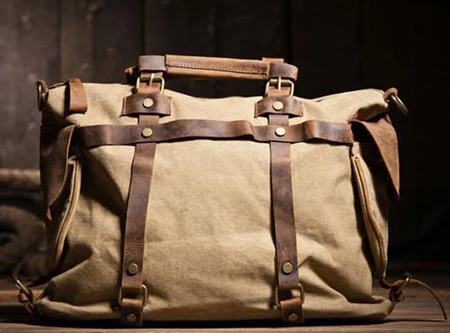
Pros:
* Excellent water resistance due to wax impregnation
* Significant durability (10+ year lifespan with proper care)
* Develops unique character and patina similar to leather
* Balance of professional and rugged aesthetic
* Generally lighter than leather options
* Lower maintenance than leather while offering similar longevity
Cons:
* Mid-high price range for quality versions
* Requires re-waxing periodically (typically annually)
* Can feel stiff when new and in cold weather
* Limited color options (typically earth tones)
* May transfer wax to contents initially
For professionals seeking a balance between formality and ruggedness, canvas leather messenger bags often combine waxed canvas bodies with leather trim and accents. This combination marries the weather-resistant properties of canvas with the refinement of leather detailing.
When comparing these premium options, many buyers consider the leather vs canvas bag durability factors. While both materials offer excellent longevity, they age differently—leather develops a polished patina while waxed canvas takes on a weathered, vintage appearance.
High-Performance Nylon: Technical Excellence for Modern Professionals
The world of high-performance nylon messenger bags has evolved dramatically beyond basic synthetic fabrics. Modern technical nylons—including ballistic nylon, Cordura, and ripstop variants—represent the cutting edge of textile engineering designed specifically for durability and performance.
High-performance nylon is categorized by denier ratings, which measure the thickness of individual fibers (higher numbers indicate thicker, stronger fibers). For example, 1000D ballistic nylon is substantially more robust than 400D pack cloth nylon, making it suitable for demanding professional environments.
These technical fabrics excel in adverse conditions where traditional materials might fail. The tightly woven synthetic fibers resist abrasion, repel water, and maintain their structure even when subjected to daily stress. For professionals who move between different environments throughout their workday, this adaptability proves invaluable.
Pros:
* Superior strength-to-weight ratio (lightest durable option)
* Excellent water and weather resistance
* Minimal maintenance requirements
* High abrasion and tear resistance
* Modern, technical aesthetic appropriate for creative industries
* Quick-drying properties
Cons:
* Less traditional/formal appearance than leather
* Mid-high price range for premium versions
* Can look worn at stress points over time
* Limited temperature regulation (can feel hot in summer)
* Some types create noise when moving
For professionals seeking maximum durability with minimal weight, high-performance nylon presents a compelling option. The ultimate guide to durable messenger bags highlights how these technical materials have earned their place among premium bag materials through superior performance metrics rather than traditional prestige.
Mid-Range Materials: Balancing Performance and Value
Top-Grain Leather: Professional Appearance with Value Considerations
Top-grain leather represents the second-highest quality grade of leather, offering a balance between performance and cost. Unlike full-grain leather, top-grain undergoes a process where the uppermost surface is sanded to remove imperfections, then finished with a protective coating. This process creates a more uniform appearance and greater initial stain resistance.
In professional environments, top-grain leather messenger bags present a polished appearance that satisfies formal dress codes. The material offers good durability for daily commuting while maintaining a refined aesthetic that complements business attire.
Pros:
* Professional appearance at a lower price point than full-grain
* Good durability (7-10 year potential with care)
* More consistent appearance than full-grain
* Lighter weight than full-grain options
* Generally more resistant to surface stains
Cons:
* Less breathable than full-grain leather
* Won’t develop the same rich patina over time
* May crack rather than wear gracefully
* Still requires regular maintenance
* Less structural integrity over extended use
The processing differences between full-grain and top-grain significantly impact long-term performance. Top-grain’s sanded surface removes the densest, strongest fibers of the hide, trading ultimate durability for improved initial appearance and lower cost. For many professionals, this represents a reasonable compromise, especially when exploring leather messenger bags at more accessible price points.
Standard Canvas: Classic Versatility with Practical Benefits
Standard canvas offers a practical middle ground for messenger bags—combining reasonable durability with everyday functionality at a moderate price point. Canvas weight (measured in ounces per square yard) significantly affects performance, with heavier weights (12-18 oz) providing better structure and longevity than lighter options.
Canvas messenger bags adapt well to various professional environments, particularly in creative fields, education, or casual office settings. The material’s natural look and texture provide a less formal alternative that still maintains professional credibility.
Pros:
* Moderate durability at an accessible price point
* Lightweight and comfortable for daily carry
* Often machine washable (depending on construction)
* Wide variety of colors and patterns available
* Casual professional aesthetic suitable for creative industries
* Less affected by scratches than leather or synthetic materials
Cons:
* Limited water resistance unless specially treated
* Shows dirt and stains more readily than other materials
* Less structured appearance over time
* Lower durability at stress points
* May fade with exposure to sunlight
When evaluating options, many professionals find canvas vs leather bags comparison research valuable for understanding the practical trade-offs. Canvas typically offers lighter weight and easier maintenance, while leather provides better weather resistance and structural integrity.
Polyester: Practical Performance for Everyday Professionals
Modern polyester has evolved significantly from its reputation in previous decades. Today’s performance polyester fabrics offer impressive durability and functional benefits at accessible price points. The material’s quality is measured in denier (thickness of fibers), with higher denier numbers indicating greater strength and durability.
Contemporary polyester messenger bags often feature sophisticated textures and finishes that elevate their appearance beyond basic synthetic looks. For professionals seeking practical daily performance without significant investment, polyester offers compelling advantages.
Pros:
* Excellent value-to-durability ratio
* Good water and stain resistance
* Lightweight and easy to clean
* Wide range of colors and patterns available
* Quick-drying properties
* Resistant to UV damage and fading
Cons:
* Less breathable than natural fibers
* Can develop static electricity
* May pill or show wear at friction points
* Generally perceived as less premium than other options
* Potential for environmental concerns (microplastic shedding)
Modern polyester manufacturing techniques have addressed many historical limitations. Advanced weaving methods, improved fiber structures, and better finishing processes have created polyester fabrics that perform remarkably well in everyday professional settings.
Budget-Conscious and Alternative Materials
PU Leather (Polyurethane): Leather Aesthetics at a Lower Price Point
PU leather (polyurethane leather) provides the appearance of genuine leather at a fraction of the cost. This synthetic material consists of a fabric base coated with a polymer layer that’s embossed and colored to resemble leather grain. It’s important to distinguish quality PU leather from cheaper vinyl/PVC alternatives, as the former offers better durability and a more convincing leather-like appearance.
For professionals seeking leather aesthetics within a limited budget, PU leather messenger bags offer an accessible entry point. The material’s uniform appearance and wide range of available finishes can create a professional impression in many work environments.
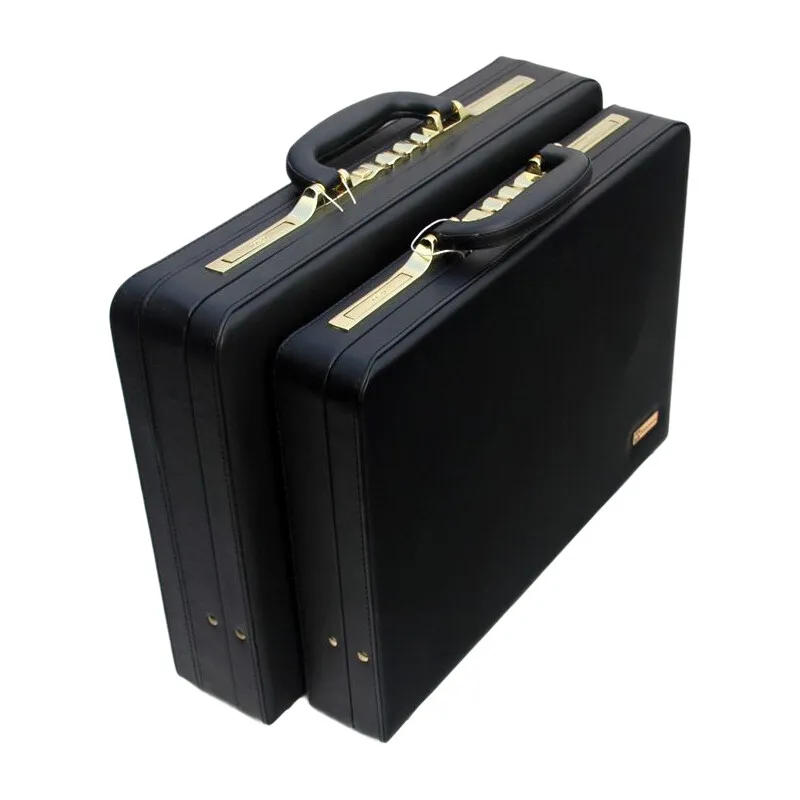
Pros:
* Leather-like appearance at a fraction of the cost
* Waterproof and easy to clean with a damp cloth
* Lightweight compared to genuine leather
* Uniform appearance without natural variations
* Wide range of colors and finishes available
* Cruelty-free alternative to animal leather
Cons:
* Limited lifespan (typically 1-3 years with regular use)
* Prone to cracking, peeling, and delamination
* Does not develop patina or improve with age
* Less breathable than genuine leather
* Cannot be effectively repaired once damaged
The quality of PU leather varies significantly between manufacturers. Higher-quality versions use thicker polyurethane layers, more durable base fabrics, and better adhesion methods that resist peeling. For those exploring vegan leather messenger bags, PU leather represents one of several available options.
For professionals interested in leather alternatives, the ultimate guide to vegan leather alternatives provides deeper insight into performance expectations and material differences among synthetic options.
Recycled Materials: Sustainable Innovation with Growing Potential
The messenger bag market has seen remarkable innovation in recycled and sustainable materials in recent years. These eco-conscious options transform waste into functional, stylish bags while reducing environmental impact. The performance of these materials continues to improve, making them increasingly viable alternatives to conventional options.
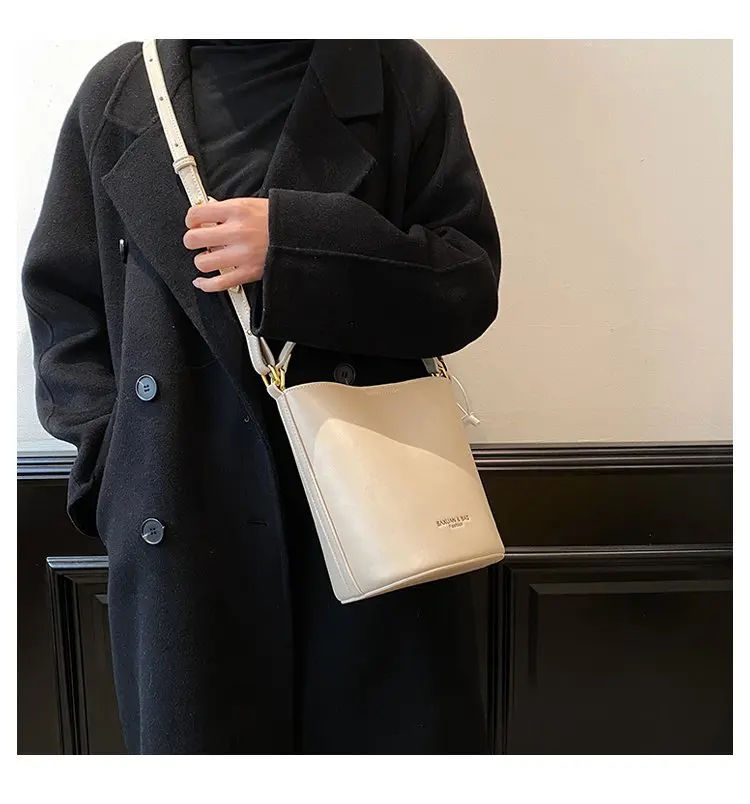
Materials to Consider:
* Recycled PET (from plastic bottles) transformed into durable polyester fabric
* Recycled nylon (including reclaimed ocean plastic) offering technical performance
* Upcycled industrial materials like truck tarps, billboard vinyl, and automotive seat belts
* Plant-based alternatives including cork, pineapple leaf fiber (Piñatex), and mushroom leather
Pros:
* Reduced environmental footprint
* Unique aesthetic and conversation-starting appeal
* Growing durability and performance characteristics
* Supporting innovation in sustainable materials
* Often water-resistant by nature
Cons:
* Variable quality and performance standards
* Generally higher cost than conventional synthetics
* Limited style and color options
* Less established longevity track record
* May require specialized care
Canvas & Leather Messenger Bag, Leather Commuter Tote
$80.41 Select options This product has multiple variants. The options may be chosen on the product pageCrazy Horse Leather Satchel, Men's Leather Satchel, Men's Professional Leather Messenger, Vintage Style Messenger Bag
$132.70 Select options This product has multiple variants. The options may be chosen on the product pageBrown Leather Messenger Bag, Men's Leather Satchel, Men's Professional Leather Messenger
$118.87 Select options This product has multiple variants. The options may be chosen on the product pageBlack Leather Messenger Bag, Black Leather Work Tote, Faux Leather Work Tote
$101.88 Select options This product has multiple variants. The options may be chosen on the product pageCrazy Horse Leather Satchel, Full Grain Messenger Bag, Men's Leather Satchel
$430.41 Select options This product has multiple variants. The options may be chosen on the product pageCrazy Horse Leather Satchel, Men's Classic Leather Briefcase, Professional Laptop Messenger
Price range: $460.43 through $536.25 Select options This product has multiple variants. The options may be chosen on the product page
Innovative companies are consistently improving these materials, addressing performance limitations while maintaining environmental benefits. For professionals who prioritize sustainability alongside functionality, these options offer a way to align personal values with professional needs.
Essential Material Property Comparison Matrix
This comparative analysis provides a direct side-by-side assessment of messenger bag materials across key performance metrics. Each material is rated on a 1-5 scale (5 being best) for objective comparison. Use this matrix to quickly identify materials that excel in properties most important to your specific needs.
| Material | Durability | Water Resistance | Weight (1=Light) | Maintenance (1=Easy) | Professional Appeal | Cost | Eco-Friendliness |
|---|---|---|---|---|---|---|---|
| Full-Grain Leather | 5 | 3 | 5 | 5 | 5 | $$$$$ | 3 |
| Waxed Canvas | 4 | 4 | 3 | 3 | 4 | $$$$ | 4 |
| High-Performance Nylon | 4 | 5 | 1 | 1 | 3 | $$$ | 2 |
| Top-Grain Leather | 3 | 3 | 4 | 4 | 4 | $$$$ | 3 |
| Standard Canvas | 3 | 2 | 2 | 2 | 3 | $$ | 4 |
| Polyester | 3 | 4 | 1 | 1 | 2 | $$ | 2 |
| PU Leather | 2 | 4 | 2 | 2 | 3 | $$ | 2 |
| Recycled Materials | 3 | 3 | 2 | 2 | 3 | $$$ | 5 |
Remember that these ratings represent averages—specific products may perform better or worse depending on quality of manufacturing, material grade, and construction methods. Environmental factors like extreme temperature, UV exposure, and humidity can also affect how materials perform in real-world conditions.
For professionals seeking alternatives to leather while maintaining professional appearance, exploring durable non-leather professional bags can provide additional guidance on selecting high-performing synthetic options.
Decision Framework: Selecting Your Ideal Messenger Bag Material
Choosing the right messenger bag material requires considering multiple factors specific to your lifestyle and needs. This systematic approach will help prioritize what matters most for your unique situation:
First, assess your primary use environment:
* Indoor-dominant use (mostly office-to-office): Aesthetic and professional appeal may outweigh weather resistance
* Outdoor-frequent use: Prioritize water resistance and durability
* Mixed environments: Seek balanced materials or consider hybrid construction
Next, evaluate your local climate and weather exposure:
* Frequent rain: Prioritize high water resistance (waxed canvas, treated leather, technical nylon)
* Hot, humid conditions: Consider breathability and light weight
* Variable conditions: Look for adaptable materials or weatherproofing options
Your professional setting formality significantly impacts material suitability:
* Formal business environments: Leather (full-grain or top-grain) maintains appropriate professional appearance
* Creative or casual professional settings: Canvas, waxed canvas, or high-quality technical materials work well
* Mixed settings: Consider more versatile options like leather-trimmed canvas
The weight and type of items you typically carry affects material needs:
* Heavy loads: Prioritize structural strength (full-grain leather, heavy canvas)
* Electronic equipment: Ensure adequate protection and padding
* Minimal essentials: More flexibility in material choice
Finally, balance these factors against your budget constraints, maintenance willingness, and ethical priorities. Someone who prioritizes minimal maintenance might prefer technical nylon despite working in a setting where leather would be ideal aesthetically. Similarly, someone with strong environmental concerns might choose recycled materials even if they require more care.
For daily commuters, the best messenger bags for daily use often balance durability with comfort and organization—factors influenced significantly by material choice.
Material Care: Maximizing Lifespan and Appearance
Proper maintenance dramatically extends the life of your messenger bag, regardless of material. Each material requires specific care approaches:
Leather Care: Condition full-grain and top-grain leather every 3-6 months with a quality leather conditioner. Clean with a slightly damp cloth and mild soap when needed, allowing to dry naturally away from heat sources. Store with tissue paper inside to maintain shape and use a dust bag when not in use. Address scratches immediately with appropriate leather treatments.
Canvas Care: Clean standard canvas with mild soap and water, allowing to dry completely before storage. For waxed canvas, avoid machine washing—spot clean with cold water and mild soap, then reapply wax annually or when water stops beading on the surface. Store canvas bags in dry environments to prevent mildew.
Synthetic Material Care: Clean nylon and polyester with mild soap and water, addressing stains promptly. Allow to dry completely before storage. For PU leather, wipe with a damp cloth and occasionally treat with vinyl protector to prevent drying and cracking. Keep all synthetic bags away from extreme heat, which can damage or warp materials.
Universal Care Tips: Regardless of material, empty your bag daily, avoid overstuffing, rotate between multiple bags if possible, and address damage immediately. Store all bags properly—stuffed to maintain shape but not under pressure from other items.
When Material Combinations Offer the Best Solution
Many of today’s finest messenger bags leverage strategic material combinations to maximize performance and aesthetics. These hybrid designs place specific materials where their strengths matter most while minimizing their weaknesses.
Leather-canvas combinations represent perhaps the most successful material partnership in messenger bags. The canvas body provides lighter weight and lower cost while maintaining good durability, while leather trim and stress points add sophistication and reinforcement where bags typically fail first. This pairing delivers better overall performance than either material alone might offer at a similar price point.
Similarly, technical bags often combine high-performance nylon with more robust materials at wear points. The primary nylon construction keeps weight low while maintaining water resistance, while reinforced corners, bases, or flap edges ensure longevity in high-friction areas.
For those seeking sustainable options, some innovative designs incorporate recycled materials for the main body with conventional materials at critical structural points—combining environmental benefits with proven performance where it matters most.
These thoughtful combinations often deliver the best overall value, addressing specific weaknesses of individual materials while maintaining their core benefits.
Beyond Materials: Other Factors That Influence Messenger Bag Performance
While material selection dramatically impacts messenger bag performance, several other factors play crucial roles in determining overall quality and longevity:
Construction Quality: The same material can perform dramatically differently based on construction techniques. Look for reinforced stress points, quality edge finishing, and appropriate material thickness for intended use.
Hardware Quality: Buckles, zippers, clasps and rings significantly impact both functionality and durability. Quality metal hardware (brass, nickel-plated brass, or stainless steel) outlasts plastic alternatives many times over.
Stitching Methods: Double or triple stitching at stress points, bartacking at corners, and appropriate thread selection dramatically extend bag lifespan.
Lining Selection: Quality linings protect contents while extending bag life by reducing internal friction and wear. Water-resistant interior linings add protection beyond the outer material’s capabilities.
Design Intelligence: Thoughtful features like padded laptop compartments, strategically placed pockets, and adjustable straps enhance functionality beyond what material alone can provide.
Even the finest material will fail prematurely in a poorly constructed bag, while thoughtful construction can help moderate materials perform beyond expectations. At Poise Porter, we consider these factors in combination with premium materials to create messenger bags that deliver consistent performance and refined appearance throughout years of professional use.

